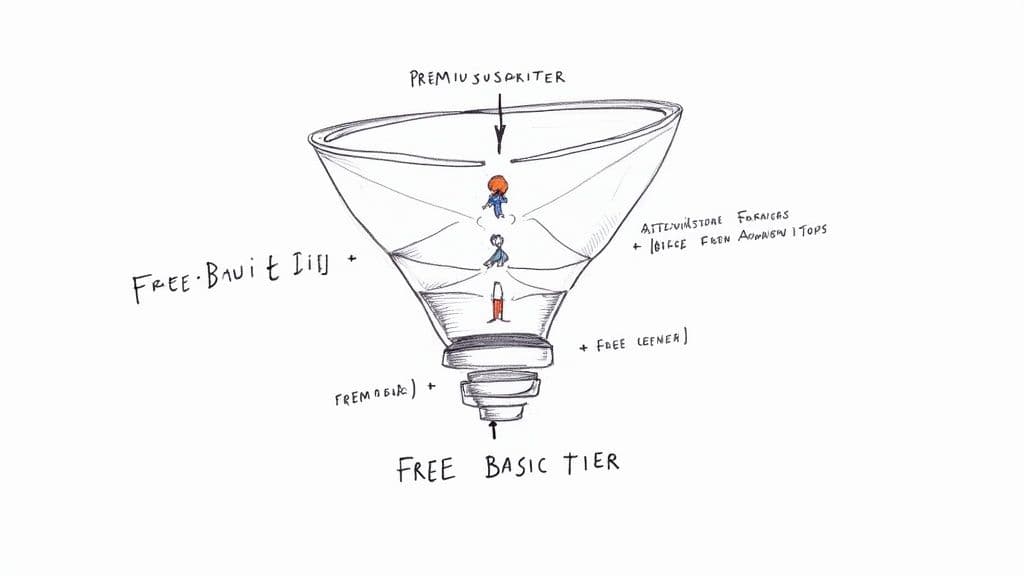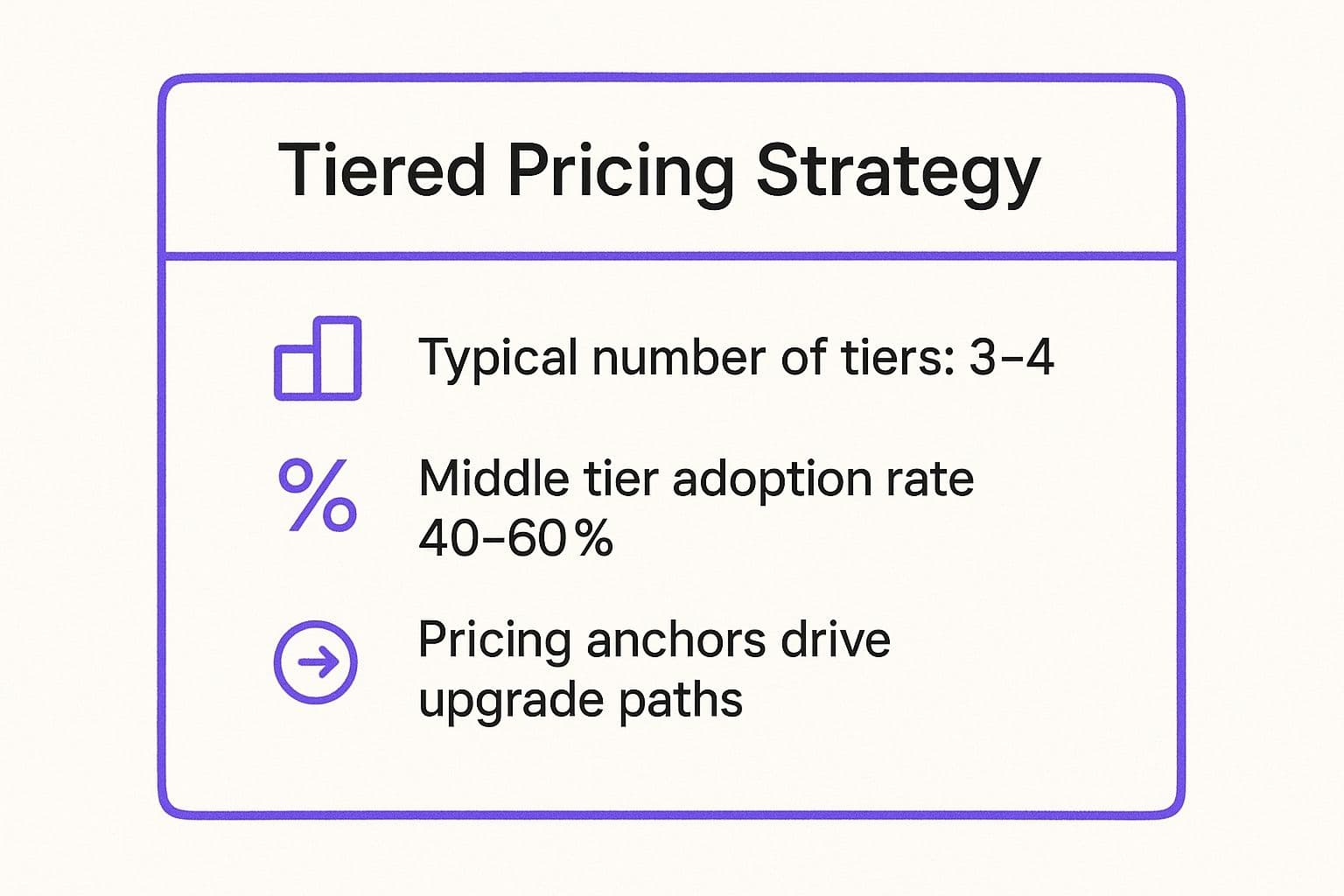Building a thriving online community is one thing; monetising it effectively is another challenge entirely. For creators, particularly those using platforms like Telegram or offering online courses, selecting the right subscription pricing strategy is the cornerstone of turning passionate followers into a sustainable income stream. An ill-fitting model can stifle growth and devalue your content, while the right one can unlock significant revenue and boost member loyalty.
This guide moves beyond generic advice to provide a practical breakdown of the top eight subscription pricing strategy models, tailored with actionable insights for community creators. We will explore the specific mechanics of each approach, from the viral potential of Freemium to the revenue-maximising power of Value-Based pricing. To truly achieve sustainable community revenue, it's also vital to explore diverse compensation and monetization strategies beyond traditional models, even drawing inspiration from other platforms.
Our goal is to equip you with the knowledge to make an informed decision that aligns perfectly with your community's unique value and your long-term business goals. Let’s dive into the practical mechanics of building a profitable subscription business.
1. The Freemium Strategy: Gaining Members Through Generosity
The Freemium model is a powerful subscription pricing strategy where you offer a basic tier of your service for free, with advanced features or exclusive content reserved for paying members. This approach is exceptionally effective for community creators as it lowers the barrier to entry to zero, allowing you to attract a large audience and build trust over time.
For a community creator, this could mean a public channel with general updates (free) and a private, paid group for exclusive discussions, live Q&As, and early access to content (premium). The core idea is to let the free tier serve as a powerful marketing funnel. By experiencing the value you provide, a portion of your free members will naturally want to upgrade for a deeper, more exclusive experience.

fde6c199-da7b-4997-8afc-17b29dab0247.jpg
Why It Works
Freemium excels at user acquisition and converting engaged followers into paying customers. It allows potential members to "try before they buy" without the time pressure of a traditional trial. Success stories like Slack (offering free plans for small teams) and Spotify (providing ad-supported music for free) demonstrate its power across different industries.
How to Implement This Strategy
A successful freemium model hinges on a delicate balance. The free offering must be genuinely useful to attract and retain members, but it also needs clear limitations that create a compelling reason to upgrade.
- Define Your Tiers Clearly: Map out exactly what free users get versus what paying members receive. For an online course creator, the free tier might include introductory videos, while the premium tier unlocks advanced modules, worksheets, and one-on-one coaching.
- Establish Natural Upgrade Points: The limitations of the free tier should feel like natural progression points, not frustrating roadblocks. This could be a limit on the number of resources they can access or participation in high-value events.
- Track Your Funnel: Monitor your conversion rate from free to paid members closely. Understanding this metric is crucial for refining your offering and is a key step in optimising your free-to-paid funnel. To deepen your knowledge, you can learn more about improving your free trial conversion rate.
This subscription pricing strategy is ideal for creators who are confident in the value of their premium offering and can support a large, free user base.
2. The Tiered Pricing Strategy: Maximising Value with Choice
The Tiered Pricing model is a highly effective subscription pricing strategy that involves offering multiple subscription levels at different price points. Each tier provides a distinct set of features, benefits, or usage limits, allowing you to cater to diverse segments of your audience, from casual followers to super-fans. This approach creates clear upgrade paths and helps maximise revenue potential.
For a digital coach, this could mean a 'Basic' tier with access to a community forum, a 'Pro' tier that adds weekly group coaching calls, and a 'Premium' tier including one-on-one sessions. The goal is to let members self-select the level of value and investment that best suits their needs, ensuring you capture a wider range of customers than a single-price model ever could.
Why It Works
Tiered pricing excels because it aligns value directly with cost, appealing to different user personas and their willingness to pay. It’s a strategy popularised by SaaS giants like HubSpot and Salesforce, who masterfully guide users from starter packages to enterprise solutions as their needs grow. This demonstrates its power to scale with your members' journey.
How to Implement This Strategy
A successful tiered model depends on creating meaningful differentiation between each level. The value jump from one tier to the next must be clear, logical, and compelling enough to encourage upgrades without devaluing the lower-priced options.
This summary box highlights the core principles for structuring your tiers effectively.

infographic-9b7ddb99-c026-401c-8490-f6d1256a797a.jpg
The data shows that a well-structured middle tier often becomes the default choice, while a higher-priced tier acts as a psychological anchor, making the middle option seem like the best value.
- Define Your Value Metric: Decide what separates your tiers. This could be the number of exclusive videos, access to live events, direct messaging privileges, or downloadable resources.
- Use Psychological Anchoring: Position your middle tier as the 'Most Popular' or 'Best Value' choice. Often, the highest tier exists not just to be sold, but to make the middle tier look more attractive and reasonably priced in comparison.
- Analyse Tier Performance: Regularly review which tiers are most popular and track how members move between them. This data is vital for optimising your pricing and features to better meet community demand.
This subscription pricing strategy is perfect for creators who have a diverse audience with varying needs and can offer a scalable range of benefits.
3. Usage-Based Pricing (Pay-as-you-Scale)
The Usage-Based model is a flexible subscription pricing strategy where customers are billed according to their actual consumption of a service. This could be based on API calls, data storage used, or the number of transactions processed. This approach directly ties the cost to the value a customer receives, creating a fair and scalable system that grows with them.
For a community creator, this might involve charging members based on the number of one-on-one coaching hours they use, how many exclusive digital resources they download, or the volume of leads generated through a private community tool. The key is to link payment directly to a measurable unit of value, making it an attractive option for users who want control over their spending.

ebd94777-8464-4311-91c3-7bee0fd57f89.jpg
Why It Works
This pay-as-you-go approach excels at aligning price with value and reducing the initial commitment for new customers. It's highly transparent and can accommodate users of all sizes, from small-scale individuals to large enterprises. Tech giants like Amazon Web Services (charging for compute and storage) and Stripe (charging per transaction) have popularised this model, demonstrating its effectiveness in scaling with customer success.
How to Implement This Strategy
A successful usage-based strategy depends on clear communication and robust tracking. Customers need to understand exactly what they are paying for and feel in control of their expenditure to avoid bill shock.
- Select a Clear Value Metric: Identify the core unit of consumption that delivers the most value to your members. For a video course platform, this might be video streaming hours; for a design community, it could be the number of premium template downloads.
- Provide Transparent Tracking: Offer a dashboard or a simple tool where members can easily monitor their usage in real-time. This builds trust and helps them manage their costs effectively, preventing unexpected invoices.
- Implement Spending Controls: Consider adding usage alerts or spending caps to give members peace of mind. For example, you could notify a member when they have used 80% of their monthly download limit, giving them the option to pause or upgrade.
This subscription pricing strategy is ideal for creators whose service consumption varies significantly among users and who can offer a clearly measurable unit of value.
4. The Value-Based Pricing Strategy: Aligning Price with Customer Success
The value-based pricing strategy sets your subscription fees based on the perceived or quantifiable value delivered to your members, rather than on your costs or what competitors charge. This sophisticated approach requires a deep understanding of the return on investment (ROI) your community provides, linking your price directly to the tangible benefits your members receive.
For a digital coach, this could mean pricing a mastermind group based on the demonstrable business growth or career advancement its members achieve. The focus shifts from "what does this cost me to run?" to "what is this outcome worth to my member?". It's a powerful way to justify premium pricing by anchoring it in the clear, positive impact you have on your customers' goals.
Why It Works
This strategy excels because it directly connects your price to the customer's success, making the subscription feel like an investment rather than an expense. It fosters strong customer relationships built on mutual success. Pioneers like Salesforce demonstrate this by pricing their CRM based on sales productivity gains, while DocuSign prices its service based on the time and cost savings it provides over traditional paper processes.
How to Implement This Strategy
Successfully implementing a value-based subscription pricing strategy hinges on your ability to clearly define, communicate, and prove the value you deliver.
- Develop Clear Value Metrics: Identify the key outcomes your members achieve. For a fitness community, this could be weight loss, improved performance metrics, or wellness milestones. For a business coaching group, it might be revenue growth or lead generation.
- Communicate the ROI: Use case studies, testimonials, and data to show potential members the tangible results they can expect. An ROI calculator on your landing page can be a highly effective tool to illustrate the financial or personal benefits.
- Gather Customer Success Stories: Actively collect and showcase quantified outcomes from your existing members. Stories that say "I increased my monthly income by 30% after joining" are far more compelling than a simple feature list. For more inspiration, you can review some real-world subscription pricing examples.
This approach is ideal for creators whose services deliver clear, measurable, and significant results, allowing them to capture a fair share of the value they create for their members.
5. The Penetration Pricing Strategy: Capturing the Market Quickly
The Penetration Pricing Strategy is a powerful subscription pricing strategy focused on aggressive market entry. It involves setting an intentionally low initial subscription price to rapidly attract a large user base, gain market share from established competitors, and build a strong brand presence. Once a significant market position is secured, prices can be gradually increased.
For a community creator, such as a fitness coach launching a new app, this could mean offering the first 1,000 members a subscription at a fraction of the long-term price. This creates immediate momentum and social proof. The core principle is to prioritise rapid adoption over initial profit margins, with the aim of establishing a loyal following that remains even after prices are adjusted.
Why It Works
Penetration pricing excels at disrupting established markets and building a critical mass of users quickly. The low barrier to entry encourages widespread trial and can create a network effect, where the service becomes more valuable as more people join. Success stories like Disney+ launching at a price significantly below Netflix, or Amazon Prime bundling services for a low initial fee, show how effective this approach is at capturing market attention and loyalty.
How to Implement This Strategy
Executing this strategy requires careful planning to ensure long-term viability. The initial low price is a short-term tactic, not a permanent business model, and must be managed with a clear path to profitability.
- Plan Your Price Increase: Before launching, map out when and how you will raise your prices. This could be tied to a specific date, a membership milestone, or the introduction of new, high-value features. Transparency with early adopters is key to retaining their trust.
- Focus on Building Loyalty: During the low-price period, your primary goal is to deliver exceptional value and build a strong community. This ensures members feel they are getting a great deal and are more likely to stay when the price eventually increases.
- Monitor the Market: Keep a close eye on competitor reactions and market dynamics. Your low price will likely trigger a response, so be prepared to adapt your strategy while staying focused on your long-term goals. To explore similar tactics, you can learn more about promotional pricing strategies.
This subscription pricing strategy is ideal for creators entering a competitive space who need to make an immediate impact and are prepared to finance initial growth for future profitability.
6. The Bundle Pricing Strategy: Maximising Value and Revenue
The bundle pricing strategy involves combining multiple products, services, or features into a single subscription package. This package is offered at a price that is lower than what a member would pay if they purchased each component separately. This approach significantly increases the perceived value for the customer, simplifies their purchasing decision, and can boost your average revenue per member.
For a community creator, this could look like bundling an online course, access to a private community group, and monthly one-on-one coaching sessions into a single, high-value subscription. The goal is to create an all-in-one solution that feels like an irresistible deal, encouraging members to commit to a more comprehensive package rather than picking and choosing smaller offerings.

a2d57e8e-1995-446b-882b-9b0185ea4cd0.jpg
Why It Works
Bundling is a powerful subscription pricing strategy because it shifts the focus from cost to value. Members are less likely to scrutinise the price of individual items and more likely to appreciate the convenience and savings of the complete package. This model was pioneered and perfected by giants like Microsoft with its Office suite and Adobe with its Creative Cloud, proving its effectiveness in locking in customers and increasing lifetime value.
How to Implement This Strategy
A successful bundle requires more than just grouping random products together; the components must have a natural synergy and offer a complete solution to a member's problem.
- Ensure Component Synergy: The items in your bundle should complement each other. A fitness coach might bundle workout plans, nutrition guides, and access to a support group, as each element supports the member's overall health journey.
- Price for Perceived Value: The bundle's price should represent a clear saving, typically a 20-30% discount compared to buying items individually. Be sure to highlight this saving in your marketing to make the value proposition obvious.
- Track Component Usage: Monitor which parts of the bundle are most used. This data is invaluable for optimising your offering, allowing you to refine the bundle by swapping less popular items for more desirable features in the future.
This strategy is ideal for creators with a diverse portfolio of offerings who want to simplify their sales process and increase the commitment level of their community members.
7. The Dynamic Pricing Strategy: Adapting to Market Demand
The Dynamic Pricing model is a sophisticated subscription pricing strategy where prices are not fixed but fluctuate based on real-time data. These adjustments can be driven by market demand, seasonality, competitor actions, or even individual customer behaviour. It allows community creators to maximise revenue by aligning their prices with current market conditions and perceived value.
For a community creator, this might involve offering a discount on an annual membership during a typically slow month to boost sign-ups, or charging a premium for a new cohort of a high-demand coaching programme. The essence of this strategy is its flexibility; it moves away from a one-price-fits-all approach to one that intelligently responds to external and internal signals, ensuring you are never leaving money on the table.
Why It Works
Dynamic pricing excels at revenue optimisation by capturing the maximum price a customer is willing to pay at any given moment. This method has been famously popularised by companies like Uber with its surge pricing during peak hours and the airline industry, which adjusts ticket prices based on demand and time until departure. It acknowledges that the value of your service can change, and your pricing should reflect that.
How to Implement This Strategy
Successfully implementing a dynamic pricing strategy requires robust data analysis and a commitment to transparency to avoid alienating your members.
- Identify Key Pricing Levers: Determine the factors that influence your community’s value. Is it seasonal (e.g., a fitness group in January)? Is it demand-based (e.g., a limited-seat masterclass)? Use these as the basis for your price adjustments.
- Be Transparent with Your Community: Avoid surprising your members with sudden, unexplained price hikes. Clearly communicate why prices might change. For example, you could offer "early bird" pricing for a course and explain that the price will increase as the launch date approaches.
- Start with Small-Scale Tests: Instead of a site-wide rollout, test dynamic pricing on a specific product or for a limited time. Use A/B testing to compare different price points and measure the impact on conversion rates and customer satisfaction before implementing it more broadly.
This subscription pricing strategy is best suited for established creators with a solid understanding of their audience's behaviour and the tools to analyse relevant data effectively.
8. The Psychological Pricing Strategy: Influencing Perception to Drive Sales
The Psychological Pricing strategy is a powerful approach that leverages human psychology and cognitive biases to make your subscription prices seem more attractive. It’s less about the actual monetary value and more about how that value is perceived. This subscription pricing strategy uses techniques like charm pricing and framing to influence a customer's purchasing decision.
For a community creator, this could be pricing a monthly membership at £9.99 instead of £10.00. While the difference is negligible, the "9-ending" price is perceived as significantly lower. This subtle shift can make the difference between a potential member hesitating and deciding to subscribe, as it frames the cost as being in a lower price category.
Why It Works
This strategy works by tapping into subconscious shortcuts our brains use to make decisions. Charm pricing (using prices ending in .99) is processed more quickly and perceived as a better deal. Similarly, anchoring sets a high-value reference point, making other tiers seem more reasonable. Notable examples include Adobe's Creative Cloud, which anchors its premium "All Apps" plan, making the single-app plans appear more affordable, and The New York Times, which frames its subscription as "£1/week" instead of "£52/year" to minimise the initial price shock.
How to Implement This Strategy
Success with psychological pricing requires careful testing and an understanding of your audience's perception of value. It's about presenting your prices in the most favourable light possible.
- Implement Charm Pricing: Test prices ending in .99 or .95 against rounded numbers. For many audiences, £19.99 feels like a much better bargain than £20.00, which can significantly boost conversions.
- Use Temporal Reframing: Break down the annual or monthly cost into a daily or weekly equivalent. A "£2.50 per week" community sounds far more accessible than a "£130 per year" commitment, even though the total cost is the same.
- Introduce a Decoy Price: Create a third pricing tier that is strategically designed to be less attractive. Its purpose is to make your preferred, often middle-tier option, look like the best value for money, a technique popularised by behavioural economist Dan Ariely.
This strategy is ideal for creators who want to optimise their pricing structure without fundamentally changing their product offering, using perception to guide members toward the most desirable action.
Subscription Pricing Strategies Comparison
| Pricing Strategy | Implementation Complexity 🔄 | Resource Requirements ⚡ | Expected Outcomes 📊 | Ideal Use Cases 💡 | Key Advantages ⭐ |
|---|---|---|---|---|---|
| Freemium Strategy | Medium - managing multiple tiers | High - supporting free users | Moderate conversion (2-5%, up to 15-20%) | SaaS, apps with scalable features | Low entry barrier, viral growth, trial without risk |
| Tiered Pricing Strategy | High - complex tier design | Medium - tier support & analysis | High middle-tier adoption (40-60%) | B2B SaaS, segmented markets | Captures segments, clear upgrade paths, revenue maximization |
| Usage-Based Pricing | High - metering & billing systems | High - real-time tracking | Scales with usage, variable revenue | Cloud services, APIs, consumable services | Aligns cost with value, appeals to variable usage customers |
| Value-Based Pricing | High - requires deep insights | Medium - customer research | Higher margins (+15-25%) | Enterprise software, ROI-focused products | Maximizes revenue, premium positioning, customer loyalty |
| Penetration Pricing | Low to Medium - price setting | Medium - marketing & scaling | Rapid market share (20-40% in 2 years) | Market entry, disruptive offers | Quick adoption, barriers for competitors, network effects |
| Bundle Pricing | Medium - product combination | Medium - pricing & usage tracking | Increases ARPU (30-50%), reduces churn (15-25%) | Multi-product/service companies | Higher revenue, reduced churn, simplified sales |
| Dynamic Pricing | Very High - data & system demands | High - analytics & ML systems | Revenue optimization, dynamic responsiveness | Market-driven sectors, demand fluctuation | Maximizes revenue, quick market adaption, personalized pricing |
| Psychological Pricing | Low - simple price adjustments | Low - pricing strategy only | Improves conversion (+8-15%) & tier shifts (20-30%) | Consumer-facing subscriptions | Easy to implement, increases perceived value, backed by research |
Implementing Your Strategy and Automating for Growth
Selecting the right subscription pricing strategy is the foundational decision that will shape your community’s growth trajectory and revenue potential. As we’ve explored, from the broad appeal of the Freemium model to the precision of Value-Based pricing, there is no single "best" answer. Your ideal approach lies at the intersection of your unique content, your audience’s needs, and your business goals. The most successful creators often don't just pick one strategy; they build a sophisticated hybrid.
Imagine combining the accessibility of a Freemium entry point with a thoughtfully constructed Tiered Pricing structure for your most engaged members. Or perhaps you could leverage Psychological Pricing tactics, like the charm pricing of £9.99 instead of £10, across all your tiers to subtly boost conversions. The key takeaway is that your initial choice is a starting hypothesis, not a permanent decision. The real work begins when you launch, gather data, and listen intently to your community's feedback.
From Theory to Action: Your Next Steps
To move from planning to profitable execution, you need a clear, actionable path forward. A robust subscription pricing strategy is not a "set it and forget it" task; it requires ongoing analysis and refinement.
- Analyse Your Audience and Value: Before settling on a model, revisit who you are serving. What is their primary pain point? What do they value most? Aligning your price with the perceived value of your solution is the most critical element.
- Start Simple, Then Iterate: Avoid over-complicating your initial offer. A simple Tiered or Value-Based model is often easier to launch and test than a complex Usage-Based system. Collect data on sign-ups, churn, and member feedback for at least one quarter before considering significant changes.
- Communicate Clearly: Whatever you choose, communicate the value of each tier or plan with absolute clarity. Members should instantly understand what they get for their money. Ambiguity is the enemy of conversion. To effectively guide users through this journey, it's also crucial to design an effective marketing funnel that clearly articulates your value proposition and persuades potential members to subscribe.
The Power of Automation in Scaling Your Community
Managing subscriptions, payments, and member access manually is simply not sustainable as you grow. For community creators, especially those on platforms like Telegram, automation is the key to unlocking scalable growth. This is where the right tools become indispensable. Automating administrative tasks frees you to focus on your true purpose: creating exceptional content and fostering a vibrant community. This focus on value is what ultimately justifies any subscription price and keeps members loyal for the long term.
Key Insight: Your subscription pricing strategy is a living part of your business. Treat it as a dynamic system that should be regularly reviewed and optimised based on performance data and member feedback, not as a one-time decision.
By embracing this mindset of continuous improvement and leveraging powerful automation tools, you transform your pricing model from a simple gatekeeper into a powerful engine for sustainable growth and community success.
Ready to implement your chosen subscription pricing strategy without the administrative headache? MyMembers automates the entire process, from creating beautiful payment pages for any pricing model to managing member access on Telegram. Stop chasing payments and start building your community. Try MyMembers today and focus on what you do best.
